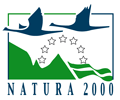Natura 2000 network
 Natura 2000 is the centrepiece of EU nature & biodiversity policy. It is a real "ecological network" spread throughout the territory of the European Union as established under the 1992 Habitats Directive. The aim of the network is to assure the long-term survival of Europe's most valuable and threatened species and habitats.
Natura 2000 is the centrepiece of EU nature & biodiversity policy. It is a real "ecological network" spread throughout the territory of the European Union as established under the 1992 Habitats Directive. The aim of the network is to assure the long-term survival of Europe's most valuable and threatened species and habitats.
The "nodes" of the network are represented by portions of lands that incorporate habitat and species particularly threatened by fragmentation, and that are placed in close relation from a functional point of view. This means that even the surrounding areas take a primary importance, even those areas that, at first, would seem to show no particular importance from the natural or scenic point of view, but which are actually the essential link between man-made environment and natural environment. They, in fact, represent the so-called "ecological corridors", those lands that are essential to put in relation to each other areas which are separate but similar to the ecological functionality.
The areas that are included in the Natura 2000 network are not strictly protected reserves where human activities are excluded, because, as the Directive says, "is intended to ensure the protection of nature while taking account also of economic, social and cultural requirements as well as regional and local characteristics."
For this reason, in addition to almost pristine natural habitats, also semi-natural environments are included in the network, transformed by humans over the centuries, in which the human's presence has allowed the maintenance of a balance between human activities and nature: the continuation and enhancement of traditional activities, such as grazing or non-intensive agriculture, are necessary for the survival of many plant and animal species associated with them. Even private individuals can be owners of Natura 2000 sites, ensuring sustainable management both ecologically and economically.
The Natura 2000 network comprises:
SCI: SITES OF COMMUNITY IMPORTANCE - established under the Habitats Directive in order to contribute significantly to maintaining or restoring a natural habitat or species at a satisfactory conservation status. Member States shall define its own list of proposed Sites of Community Importance (pSCI) on the basis of specifically identified and defined criteria. For the approval of the SCI, the list is formally transmitted to the European Commission, together with, for each site identified, a standard form and completed with cartography. The SCI, after a verification step by the European Commission, will be transformed by the Minister for the Environment in SAC: SPECIAL AREAS OF CONSERVATION.
SPA: Special Protection Areas - established under the Birds Directive to protect strictly the sites where certain species of birds live in, that have become rare and endangered species, as well as the protection of migratory species, with particular reference to wetlands of international importance established under the Ramsar Convention. Then the Ministry of Environment subsequently transmits forms and maps to the European Commission, so the Special Protection Areas will automatically become part of the Natura 2000 network.
In Italy, the SCIs and SPAs in total, cover about 21% of the national territory.
Further information about the European Union's Natura 2000 network can be found on the website
http://ec.europa.eu/environment/nature/index_en.htm
Documents
- Directive 09/147 EC of 30 November 2009 on the conservation of wild birds (replaces the previous Council Directive 79/409/EEC of 2 April 1979)
- Directive 74/409/EEC, 2 April 1979, conservation of wild birds
- Directive 92/43/EEC, 21 May 1992, on the conservation of natural and semi-natural habitats, and wild fauna and flora
- DPR n.357, 8 September 1997, Regulation implementing Directive 92/43/EEC
- Decree of the Ministry of Environment, 3 April, 2000. List of Special Protection Areas established under Directive 79/409/EEC and the proposed Sites of Community Importance proposed to Directive 92/43/EEC
- Decree of the Ministry of Environment, 3 September 2002. Guidelines for the management of Natura 2000 sites
